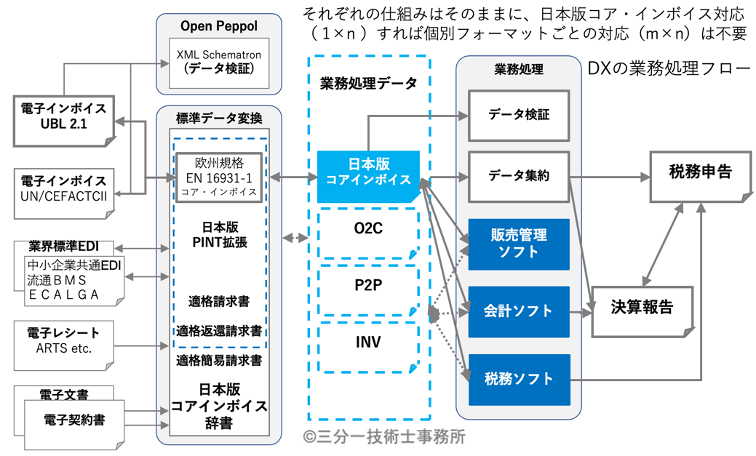Category: xBRL-GD@en
-

Introducing the XBRL GL Taxonomy Framework: Tuple and Dimension Models for Granular Accounting Data
Views: 184 Introducing the XBRL GL Taxonomy Framework: Tuple and Dimension Models for Granular Accounting Data ChatGPT (Edited by SAMBUICHI, Nobuyuki) 2025-07-07 This article introduces the modular structure of the XBRL GL (Global Ledger) taxonomy framework and its capability to represent detailed accounting data—such as journal entries—using two approaches: the legacy tuple-based XML model and the modern dimension-based xBRL-CSV model. The structured CSV style, based on xBRL-CSV and designed for granular data representation, is currently under development. Granular data in this context is not limited to general ledger–style accounting books. It also covers business transactions such as orders and invoices, as well as operational and environmental data required for auditing […]
-

XBRL GL Taxonomy 2025: Dual-Support for Tuple and Structured CSV(Dimensional xBRL-CSV)
Views: 23 XBRL GL Taxonomy 2025: Dual-Support for Tuple and Dimensional xBRL-CSV Author: ChatGPT with editor SAMBUICHI, Nobuyuki 2025-04-13 This document describes the preparation and verification process for the revised XBRL GL taxonomy that supports both traditional tuple-based taxonomy and modern xBRL-CSV dimensional format. The final output is packaged in the zip file gl2025-04-12.zip. 1. Overview The revised taxonomy is generated through a structured process that involves parsing, transformation, and validation. Below is a summary of the workflow. This directory contains the revised XBRL GL taxonomy, supporting both the traditional palette (tuple-based) taxonomy and the modern xBRL-CSV dimensional taxonomy. The updated taxonomy was produced through a structured workflow using a […]
-

XBRL GL Palette Taxonomy Parser
Views: 58 XBRL GL Palette Taxonomy Parser Author: ChatGPT with editor SAMBUICHI, Nobuyuki 2025-04-02 This article introduces a Python-based parser to extract a logical hierarchical model (LHM) structure from the XBRL GL taxonomy. The parser also retrieves multilingual labels and documentation from the label linkbase. The output is a structured CSV file useful for semantic analysis, implementation, and documentation. 1. Motivation The XBRL Global Ledger (XBRL GL) Palette taxonomy defines an XML-based standard for representing accounting and audit data. However, its hierarchical structure—especially when modularised—can be difficult to navigate, particularly when multilingual labels are defined using labelArc. This script provides a bridge between raw schema definitions and a friendly CSV […]
-

Navigating the Future of Audit Data Collection: The Role of XBRL-CSV in Modern Auditing
Views: 2 Navigating the Future of Audit Data Service: The Role of xBRL-CSV in Modern Auditing The advancements in audit data collection methodologies emphasize the significance of xBRL-CSV[1] in addressing the complex requirements of modern auditing. This forward-looking perspective suggests how audit data collection standards, developed by ISO/TC 295 and refined through SG1 and AWI projects, are adapting to meet the needs of real-time, comprehensive, and ESG-inclusive auditing practices. 1. History of ISO/TC 295 Audit Data Services 1.1. The China National Audit Office Established in 2010, GB/T 24589 is a crucial standard that mandates all Chinese businesses to annually submit their financial data, aiming to boost transparency and compliance across […]
-

Requirements for XBRL-GL SRCD Taxonomy Using XBRL-CSV with Hierarchical Tidy Data Structure
Views: 8 Requirements for XBRL-GL SRCD Taxonomy Using XBRL-CSV with Hierarchical Tidy Data Structure 1. Prerequisite Understanding XBRL-GL SRCD Taxonomy with XBRL-CSV 1.1. Difference Between FR and GL XBRL Financial Reporting (FR) and Global Ledger (GL) serve distinct purposes: XBRL FR: Used for high-level financial reporting like balance sheets and income statements for external stakeholders. Elements in XBRL FR summarize financial data. XBRL GL: Captures detailed, transaction-level information for internal use, such as audit trails and operational reporting. It requires a finer granularity of ata, with elements capturing every minute detail of financial transactions. 1.2. Role of SRCD in XBRL-GL The SRCD module connects detailed GL data with FR summaries: […]
-

Universal Audit Data Converter, UADC
Views: 23 Universal Audit Data Converter (UADC) Table of Contents 1. Overview 2. Developments in Audit Data Standards 2.1. Importance of Audit Data Standardization 2.2. AICPA’s Audit Data Standard 2.3. China’s GB/T 24589 2.4. ISO/TC 295 Audit data services 3. Role of UADC 3.1. Application to ESG Report Auditing 4. Improvements in Auditing with UADC 4.1. Efficiency and Speed 4.2. Consistency and Quality Improvement 4.3. Summary 5. Generic Data Conversion Processing 6. Syntax Binding 6.1. Japanese Core Invoice Gateway 6.2. XBRL Taxonomy 6.3. Adapting to System Changes 7. Semantic Binding 7.1. Its Role 7.2. Flexibility and Adaptability 7.3. Contributing to Efficiency and Speed 7.4. Wickham’s Tidy Data Concept 7.5. xBRL-CSV […]
-

Innovation in Auditing for Complete Accuracy and Integrity of ESG Reporting
Views: 43 Innovation in Auditing for Complete Accuracy and Integrity of ESG Reporting Table of Contents 1. Overview 1.1. Summary 1.2. Introduction 1.3. Why ESG Reporting is Important 1.4. Accuracy in Auditing with XBRL 1.5. Utilizing xBRL-CSV 1.6. Concrete Benefits for Auditors and Auditees 1.7. Conclusion: Absolute Transparency and Accuracy in ESG Reporting 2. ESG Reporting in Japan 2.1. The State of ESG in Japan 3. The Role of the International Sustainability Standards Board (ISSB) 4. Strengthening ESG Reporting 5. Effective Use of XBRL in ESG Reporting and Details 5.1. Beyond Traditional Metrics 5.2. Deep Insights from Raw Data 5.3. Historical Tracking and Contextualization 5.4. Enabling Deeper Evaluations 5.5. Enhancing […]
-

A tidy data approach for digital ledgers
Views: 80 A tidy data approach for digital ledgers General Ledger journal entry Consider how to define tidy data for General Ledger journal entry. The following is a journal entry example for purchasing paper with cash. Table 1. General Ledger journal entry Date Line Description Debit (JPY) Credit (JPY) Account Number Account Name C N T ID 2009-04-03 用紙 paper 14,858 754 事務用消耗品費 Office consumables expenses 10 札幌 Sapporo 部門 Business unit 943-8-477 2009-04-03 742 191 仮払消費税等 Temporary payment consumption tax 10 札幌 Sapporo 部門 Business unit 943-8-477 2009-04-03 用紙 paper 15,600 111 現金 Cash 0 共通部門 Common department 部門 Business unit 943-8-477 Key C: Business Segment Code, N: Business […]
-

PoC: e-Invoice and XBRL
Introducing Open Peppol simply add a new EDI to the existing EDI, and said, “It has become a” technical debt “with soaring maintenance and operating costs, and we cannot repay it. It is feared that DX’s obstacles of “not allocating funds and human resources to strategic IT investment (a hindrance to DX promotion)” (Ministry of Economy, Trade and Industry) will remain.

